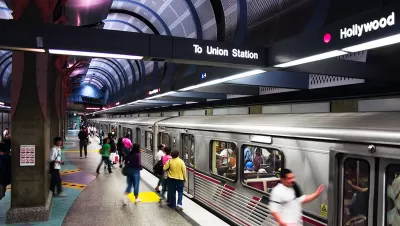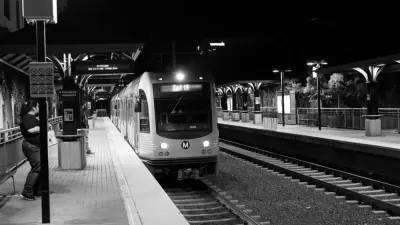Research links high ridership levels with lower crime, signaling that, rather than introducing new security measures, transit agencies should focus on bringing riders back to their systems.

In an opinion piece in the Los Angeles Times, Madeline Brozen urges Los Angeles Metro to look to the system’s buses as a model for how to improve transit safety.
While the agency is deploying added security, transit ambassadors, and other tools such as loud music to deter crime in its stations, Brozen writes that those may not be enough to make trains safer. Yet riders on the system’s buses experience far less crime than train users. “Buses aren’t safer because their rubber tires act like crime-fighting vigilantes. The most likely explanation for why buses are safer is because more people use them.”
“As fewer people rode public transit — particularly the train system — social norms eroded. Behaviors changed from minor issues like passengers putting their feet on seats to more concerning behaviors like smoking cigarettes or openly using drugs.” According to Brozen, “The best way forward is to take lessons from the bus and get more people on board to enforce public transit’s social norms.”
To bring back ridership, Brozen suggests “focusing on rail riders who are not weekday commuters,” a strategy recently undertaken by San Francisco’s Bay Area Rapid Transit Authority (BART). Brozen also recommends activating rail stations, which are often empty and isolated.
Ultimately, “Whatever steps L.A. Metro takes to address crime should be good solutions for transit in general, not just for safety,” and transit can’t solve larger societal problems. But “The bus system’s relationship between more riders and less crime is proof positive” that boosting ridership can be one tool for addressing transit safety.
FULL STORY: Opinion: How can L.A. Metro make train service safer? Look to what’s working on buses

Study: Maui’s Plan to Convert Vacation Rentals to Long-Term Housing Could Cause Nearly $1 Billion Economic Loss
The plan would reduce visitor accommodation by 25,% resulting in 1,900 jobs lost.

North Texas Transit Leaders Tout Benefits of TOD for Growing Region
At a summit focused on transit-oriented development, policymakers discussed how North Texas’ expanded light rail system can serve as a tool for economic growth.

Why Should We Subsidize Public Transportation?
Many public transit agencies face financial stress due to rising costs, declining fare revenue, and declining subsidies. Transit advocates must provide a strong business case for increasing public transit funding.

How to Make US Trains Faster
Changes to boarding platforms and a switch to electric trains could improve U.S. passenger rail service without the added cost of high-speed rail.

Columbia’s Revitalized ‘Loop’ Is a Hub for Local Entrepreneurs
A focus on small businesses is helping a commercial corridor in Columbia, Missouri thrive.

Invasive Insect Threatens Minnesota’s Ash Forests
The Emerald Ash Borer is a rapidly spreading invasive pest threatening Minnesota’s ash trees, and homeowners are encouraged to plant diverse replacement species, avoid moving ash firewood, and monitor for signs of infestation.
Urban Design for Planners 1: Software Tools
This six-course series explores essential urban design concepts using open source software and equips planners with the tools they need to participate fully in the urban design process.
Planning for Universal Design
Learn the tools for implementing Universal Design in planning regulations.
Ascent Environmental
Borough of Carlisle
Institute for Housing and Urban Development Studies (IHS)
City of Grandview
Harvard GSD Executive Education
Toledo-Lucas County Plan Commissions
Salt Lake City
NYU Wagner Graduate School of Public Service





























